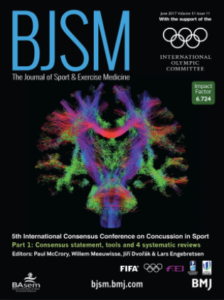Objective: This study presents data using multimodal assessment via impact sensors and oculomotor function to quantify neurophysiological changes in the acute period following concussion.
Design: Cohort study.
Participants: Data on impact magnitude and frequency were collected with a wireless head impact sensor (XPatch1) worn by senior amateur rugby players participating in a domestic season. King-Devick Tests were performed pre-season and after significant impact scores (PLA>100 g, PRA>10,000 rads/sec/sec). Participants underwent a one-hour baseline assessment of balance, cognition and transcranial magnetic stimulation testing. Following concussive episodes or significant head impacts (as measured by impact sensors), players were re-tested to elicit any differences and to assist in providing objective criteria for the return to play process.
Interventions: Any impact that resulted in a witnessed concussion or that was suspected on the basis of significant impact scores required post-match testing utilizing the King-Devick Test to help determine appropriate return to play readiness.
Outcome measures: Impact number, peak linear and peak rotational acceleration, risk weighted exposure. Time and errors completing the King-Devick Test.
Main result: 20 concussions were detected in all, of which only 3 were witnessed (2 players unconscious on the field, one with balance disturbance resulting in removal from play).
Conclusions: A combination of regular impact monitoring and King-Devick Ocular testing provides a relatively simple process for objectively identifying and managing concussion in sports participants.
Summary Points:
- The K-D Test is useful in objectively identifying and managing concussion in sports participants.
- It is particularly helpful in detecting unwitnessed head injuries which comprised the majority of the diagnosed concussions in this study (17/20) compared to only 3 witnessed injuries with overt concussion symptoms.

